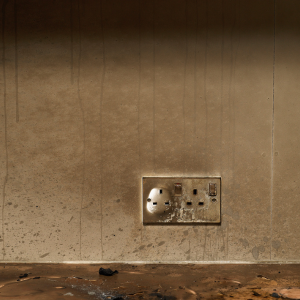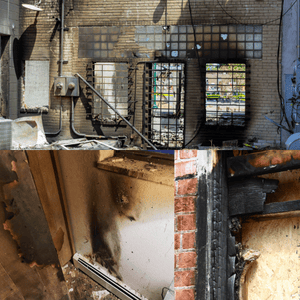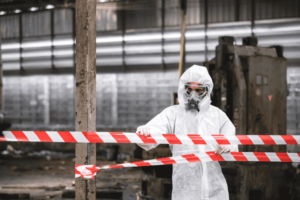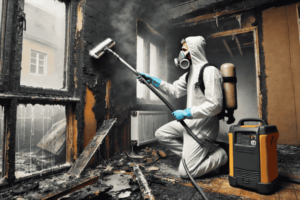After a fire, the damage left behind can feel overwhelming—knowing what types of fire damage exist can help you understand what’s ahead. Fires leave more than just ashes and charred remains; they impact every part of your home in ways that may not be immediately visible. By understanding the different types of fire damage, you can make informed decisions, speed up your recovery, and ensure your insurance claims go smoothly.
Here at All Nation Restoration, we’re committed to helping you through each step. From structural damage to lingering smoke and even hidden chemical residues, each type of fire damage needs unique attention. Let’s explore what each type of damage entails and how you can start restoring your home.
The Heat’s Aftermath: How Thermal Damage Impacts Your Property
Thermal damage, or heat damage, is a powerful force during a fire. Imagine the intense heat generated—hot enough to warp metal and compromise structural materials. This extreme heat doesn’t just burn surfaces; it can weaken the very bones of your home. Wood, metal, and even concrete can be altered by heat, causing them to warp, crack, or lose integrity.
Why is this important? Weakened building structures pose safety risks long after the fire is out. Beams may no longer support weight, metal fixtures may warp, and windows may lose their protective strength.
Restoration Tips: When it comes to thermal damage, assessing structural integrity is essential. Working with professionals who know what to look for can save you from unexpected hazards. Structural engineers and fire restoration specialists can help pinpoint areas needing reinforcement or replacement.
Lingering Smoke Damage
Smoke damage might sound like just an inconvenience, but it’s more than a lingering smell. Smoke particles can cling to walls, furniture, and even embed in fabrics. Worse, it can affect air quality in areas far from the flames. Depending on the type of fire, smoke damage can take different forms.
Types of Smoke:
- Wet Smoke: Produced by smoldering fires, it leaves a sticky residue.
- Dry Smoke: Often from fast-burning fires, this smoke leaves a powdery, lighter residue.
- Protein Smoke: Common in kitchen fires, it’s nearly invisible but leaves an intense, lingering odor.
Each type of smoke affects your home differently, making clean-up a challenge. Wet smoke might cling to walls and furniture, while protein smoke lingers in the air and can ruin the smell of a room.
Remediation Tips: Start by airing out your home as much as possible. Use fans, open windows, and circulate fresh air. For more thorough cleaning, consider professional equipment to remove smoke particles. We recommend working with experts to address severe air quality issues—our team at All Nation Restoration has specialized equipment that goes far beyond what most household tools can achieve.
Soot Damage and Its Lasting Impact

Soot is a byproduct of incomplete combustion, leaving a greasy, oily residue that clings to everything it touches. This residue can stain walls, ruin upholstery, and wreak havoc on electronics and ventilation systems. Unfortunately, soot isn’t just unsightly; it’s corrosive and can continue to damage surfaces if left untreated.
Effects on Your Belongings:
- Electronics: Soot particles can invade and damage the internal components.
- Furniture: Fabric absorbs soot, creating difficult-to-remove stains and odors.
- Air Vents: Soot clogs ventilation, reducing air quality and recirculating particles through your home.
Cleanup Advice: When tackling soot, avoid spreading it further. Specific cleaning agents are required to break down the oily residue, so don’t hesitate to call in professionals who can ensure a thorough cleanup. We recommend protecting porous surfaces and addressing ventilation systems to prevent the soot from spreading.
Read more: Guide to Cleaning Anything Affected by Fire or Smoke
Water Damage After a Fire: The Price of Extinguishing Flames
Water damage may not be the first thing that comes to mind after a fire, but the water used to extinguish flames can cause significant damage. Soaked flooring, waterlogged walls, and wet insulation create ideal conditions for mold growth, weakening structures and materials.
Commonly affected areas include:
- Floors: Carpet, wood, and tile can all suffer from water saturation.
- Walls and Insulation: Absorb water quickly, leading to weakened drywall and potential mold growth.
- Furniture and Fabrics: These may retain water and need special drying treatments.
Tips on Restoration: First, remove any standing water and ventilate affected rooms as soon as possible. Mold prevention is critical, so work with a team that specializes in drying and dehumidification. Our team at All Nation Restoration can ensure your home is properly dried and treated to avoid long-term water damage issues.
Chemical Residues: The Hidden Danger After the Fire
Fires involving synthetic materials or household chemicals can leave behind harmful residues. These residues aren’t just another cleaning task—they can be hazardous to your health. Chemicals released from burning plastics, cleaning products, and extinguishing agents can settle on surfaces, posing serious risks if inhaled or touched.
Health Risks of Chemical Exposure:
Residues from burned chemicals may contain toxins that irritate the skin, eyes, and respiratory system. It’s crucial to thoroughly clean affected areas to ensure your space is safe for you and your family.
Cleanup Tips: This isn’t a task to tackle on your own. Professionals trained in hazardous material removal know how to handle these residues safely and effectively. We recommend leaving chemical cleanup to those with the right equipment to ensure safety and thoroughness.
Read more: 10 Tips to Prevent House Fires
Electrical Damage: Fires that Short-Circuit Your Home’s Safety
Fires can disrupt electrical systems, affecting wiring, outlets, and even appliances. When flames and heat damage wires, circuits, and other electrical components, you’re left with a hidden safety hazard. Attempting to use damaged electrical systems can lead to further fires or power surges.
Risks of Re-using Electronics or Power Systems:
Even if things look okay, damaged wiring may cause malfunctions or sparking. Resist the urge to turn things back on without inspection.
Recommended Steps: Hire a licensed electrician to inspect all electrical components. They can identify compromised areas and recommend rewiring or replacing damaged systems.
Structural Damage: When the Bones of Your Home Are Affected

Fires can weaken the very bones of your home. Load-bearing walls, beams, and even foundations might sustain heat damage, leaving your home vulnerable to collapse. This structural damage isn’t always visible but can create long-term stability issues if ignored.
Importance of Structural Inspections:
For safety, a thorough inspection is essential. Structural engineers can assess which parts of the home are salvageable and which require replacement.
Restoration Advice: Collaborate with engineers and restoration experts who can identify unsafe areas and reinforce structures as needed. The last thing you want is to move back in only to face another disaster.
Moving Forward After The Types of Fire Damage: What’s Next?
Experiencing a fire is overwhelming, but addressing each type of fire damage can make your path to recovery smoother. By understanding thermal, smoke, soot, water, chemical, electrical, and structural damage, you’ll know what to look for and how to respond effectively. FEMA has this resource with tips on what to do after a fire.
Here’s our final piece of advice: prioritize safety and enlist professional help when needed. At All Nation Restoration, we’re here to guide you through each step, ensuring every type of damage is addressed. From assessing structural integrity to improving air quality and cleaning up chemical residues, we’ve got you covered.
When you’re ready to move forward, reach out to us. Let All Nation Restoration help you restore your home, giving you peace of mind and a solid path back to normalcy.
Keep Reading: Preparing for a Fire Damage Insurance Claim: What to Document and Why It Matters







